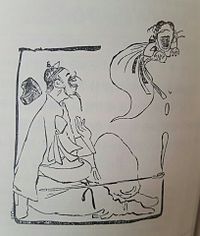

Superstition in Korea, rooted in Korean shamanism, exists in many parts of Korean life. In Korean shamanic faith, folk beliefs have been passed down through generations.[1] During the Joseon Dynasty, Confucianism and shamanism flourished.[2] Although Confucianism has no god figure, there are supernatural phenomena within the belief system of Korean shamanism.[3]

Some Korean superstitions are similar to Chinese or Japanese superstitions. Many Korean superstitions are related to being afraid of uncertain situations or avoiding certain actions.[4]
The following movies deal with Korean superstitions:
In modern society, relying on superstitions has declined as there is more of an emphasis on rationality.[25] As a result, many people are critical of acting on superstitious beliefs.[26] Blindly turning to superstition, however, can still comfort the mind.[27]
There is an ongoing debate on whether ancestral rites (Jesa) or jwibulnori, which are famous Korean traditional plays, are viewed as mere superstitions or as an important aspect of the country's culture.[28]
{{cite news}}: Check |url= value (help)
{{cite news}}: CS1 maint: numeric names: authors list (link)
{{cite news}}: CS1 maint: numeric names: authors list (link)